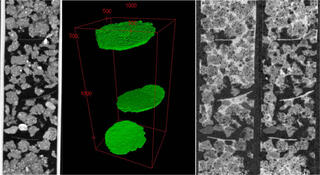Detritusphere microenvironments play an important role in carbon dynamics

within the sample and identified using xCT (center). After water addition, the same samples were subjected to nCT every hour. nCT images represent t=0 (left) and t=19 (right).
Objective
To explore micro-environmental conditions within the detritusphere, the environment formed around decomposing leaves, and the relationships between moisture distribution, enzyme activity, and carbon dynamics during decomposition.
Approach
Researchers assessed spatial and temporal dynamics of moisture distribution using X-ray and neutron computed tomography, and activities of β-glucosidase and chitinase enzymes involved in carbon and nitrogen processing using zymography. They used carbon-13 labeled residue to track contributions to atmospheric and soil carbon. Soil microcosms were created with corn and switchgrass leaves incorporated into soils from annual cropping and perennial grassland systems with contrasting pore size characteristics.
Results
Findings suggest that decomposition dynamics of plant residues is a combined effect of vegetative history, in part through its impact on microbial communities, the chemical and physical characteristics of plant residue, and soil pore structure, which together create temporally dynamic micro-environmental conditions that influence decomposition.
Impact
Soil organic carbon (SOC) sequestration has the potential to mitigate atmospheric carbon levels and climate change. Understanding the biophysical and biochemical processes of the detritusphere is critical to quantifying and modeling SOC accrual.